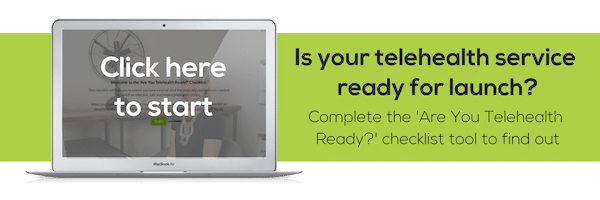How We Conduct Online Physiotherapy Consultations

When I started doing online physiotherapy consultations in 2011, all I had was a simple website and a skype account. The way that I conduct online Physiotherapy consultations has changed a lot since then. I often get asked by other health professionals how I actually ‘do’ online Physiotherapy consultations, so I thought I would share an overview of my process. Thanks to some great technology platforms, telehealth is now about much more than just video calls.
Step One: Subjective Assessment
To initiate an online Physiotherapy consultation, the patient clicks a link in our website to activate our Subjective assessment form. This is a beautifully designed, conversational smart form, which adapts depending on what their answers are at each stage. All of the expected subjective assessment questions are included, including special questions according to what body part is involved.
When the patient clicks submit, we get a push notification, and we can then go to our inbox to read the completed subjective assessment form.
(If it arrives in the middle of the night it will simply be checked in the morning).
Step Two: Objective
Once I have read the subjective assessment, I will respond to the patient with any further questions that the subjective assessment has raised. I will also send a link to a basic self-guided objective assessment. The patient can complete this in their own time, with clear instructions vie photos and videos to show them what to do. Safety is of course paramount, and we ensure that the patient is well aware that they do not need to complete any test that provokes pain or that they are not comfortable with.
Step Three: Video call
By the time we reach the video call, I already have a considerable amount of information about the patient and their condition. This takes a lot of pressure off the video call, and means it can be shorter. The purpose of the call is to confirm any further questions, complete any further tests, build rapport with the patient and educate them regarding the next steps for their recovery.
Step Four: Diagnosis and Report
Following the video call, I will write up a summary incorporating the patient’s likely diagnosis, contributing factors, goals and plans. Although completely personalized to the patient, we use a template system to make the development of the report time efficient.
Step Five: Exercise Prescription
I will then develop the patient’s rehabilitation program within the exercise prescription app, Physitrack. This program and the report, are sent through to the patient. The patient can access the exercises through a free app on their smartphone. The app has the ability to record outcome measures, daily pain ratings, and allow the patient to set reminders to exercise.
Step Six: Follow up
Physitrack houses a secure messaging feature, and this is how my patient and I continue to communicate following completion of the assessment phase. I guide the patient to report back to me at certain intervals, but I also set a reminder to reach out to them in case they forget. Once the patient reaches the end of their recovery journey, we will ensure they have a preventative program to continue. If the patient’s progress is not satisfactory, we will refer them to the relevant service.
Telehealth provides exciting opportunities to reach and help more people, but it also raises many questions. I hope this overview has given you some interesting insight into the online Physiotherapy consultation process. Be sure to let me know if you have any telehealth questions you would like answered.

How can we convince the patients or relatives about effectiveness of online Pt
Hi Raj, thanks for your question. I feel that convincing patients comes from creating great quality content that builds credibility and educates. Blogs, videos and social media are all important ways to reach out and educate. There is no magic answer, just finding ways to communicate with your potential audience and offer them some value.
Hi Karen,
A really great post and interesting to see how transferable the elements of a face-to-face assessment are. How do you work around being unable to objectively test for red flags?
Thanks!
Chloe
Hi Chloe, thanks so much for reaching out. In the online format we can obviously ask all of our ‘red flag’ questions in our subjective assessment as we would normally do ‘in person’. In terms of objective testing, what are some examples that come to mind for you?
Hi Karen,
As Chloe has asked, how do you get around not being able to actually lay hands on the client for special test purposes?
For example if you wanted to complete a special test such as Hawkins Kenedy for the shoulder, or even as simple as resisted tests such as empty can for the rotator cuff or the bicep tendon irritation test, or talar tilt for the ankle ligaments.
Thanks
Hi April, yes very good question.
So first of all, if we are talking about diagnosing shoulder impingement, think about all of the things in a subjective assessment that would already be pointing you to impingement. Then think of all of the objective movements you could easily guide your patient to do that would also be pointing your clinical reasoning brain to impingement. By the time you get to the HK test, in most instances, it is just confirming what we already know. But IF you still wanted to complete the test, simply guide your patient to rest their upper arm along the edge of a solid shelf or dining table, and then use the other hand to internally rotate and overpress the shoulder into internal rotation. Take the time to explain, give appropriate warnings, and then get the to give you feedback. Compare both sides and you’re done!
Empty can can also be quite straight forward for a patient to self overpress. For the ankle you can of course look at active range, and if you really wanted a talar tilt, guide the patient to take the ankle passively into internal rotation.
There are a few special tests you will never be able to guide a patient to replicate. In these instances, fill the gap with the wealth of information you can glean from a thorough subjective, and many other objective movements that you can direct the patient to do.
I hope this helps!
Hi Karen, thank you for all the information and help you are giving physio community. Could I ask if you can recommend any bluetooth mics to connect to my phone while I’m demonstrating exercises/movements etc? Any brands or considerations? thanks
Great question Claire. I am an Apple user, so i use my Airpods for this. They can connect to my laptop or my phone. Any bluetooth phone headset should work though.The main thing is that it fits well and doesn’t fall off when you move!
Yo creo que un fisioterapista tiene que tener contacto con los pacientes para poder evaluar y así saber que será su tratamiento
I understand. We all have our own assessment of where our value lies as a therapist. Perhaps this article may help: https://www.karenfinnin.com/telehealth-destroying-physio-profession/